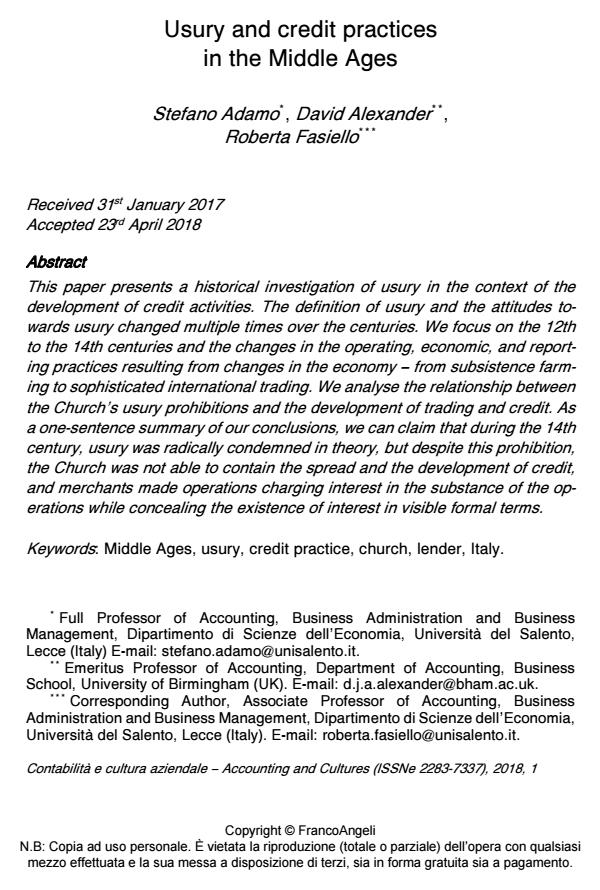Usury and credit practices in the Middle Ages
Titolo Rivista CONTABILITÀ E CULTURA AZIENDALE
Autori/Curatori Stefano Adamo, David Alexander, Roberta Fasiello
Anno di pubblicazione 2018 Fascicolo 2018/1
Lingua Inglese Numero pagine 33 P. 37-69 Dimensione file 196 KB
DOI 10.3280/CCA2018-001004
Il DOI è il codice a barre della proprietà intellettuale: per saperne di più
clicca qui
Qui sotto puoi vedere in anteprima la prima pagina di questo articolo.
Se questo articolo ti interessa, lo puoi acquistare (e scaricare in formato pdf) seguendo le facili indicazioni per acquistare il download credit. Acquista Download Credits per scaricare questo Articolo in formato PDF

FrancoAngeli è membro della Publishers International Linking Association, Inc (PILA)associazione indipendente e non profit per facilitare (attraverso i servizi tecnologici implementati da CrossRef.org) l’accesso degli studiosi ai contenuti digitali nelle pubblicazioni professionali e scientifiche
This paper presents a historical investigation of usury in the context of the development of credit activities. The definition of usury and the attitudes towards usury changed multiple times over the centuries. We focus on the 12th to the 14th centuries and the changes in the operating, economic, and reporting practices resulting from changes in the economy - from subsistence farming to sophisticated international trading. We analyse the relationship between the Church’s usury prohibitions and the development of trading and credit. As a one-sentence summary of our conclusions, we can claim that during the 14th century, usury was radically condemned in theory, but despite this prohibition, the Church was not able to contain the spread and the development of credit, and merchants made operations charging interest in the substance of the operations while concealing the existence of interest in visible formal terms.
Parole chiave:Middle Ages, usury, credit practice, church, lender, Italy
- Peculiarities of Accounting Practices in Francesco Datini’s Partnership in Pisa Mikhail Kuter, Charles Richard Baker, Marina Gurskaya, Roza Sagitova, in Accounting Historians Journal /2024 pp.39
DOI: 10.2308/AAHJ-2021-024 - The emergence of bills of exchange in the late medieval and early modern periods in Europe Charles Richard Baker, Bruno Cohanier, in Accounting History /2025 pp.341
DOI: 10.1177/10323732251331978 - Banks and financial institutions in historical perspective Valerio Antonelli, Nieves Carrera, Christopher Napier, in CONTABILITÀ E CULTURA AZIENDALE 1/2018 pp.9
DOI: 10.3280/CCA2018-001002
Stefano Adamo, David Alexander, Roberta Fasiello, Usury and credit practices in the Middle Ages in "CONTABILITÀ E CULTURA AZIENDALE" 1/2018, pp 37-69, DOI: 10.3280/CCA2018-001004